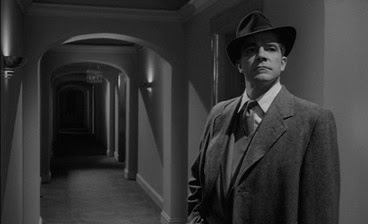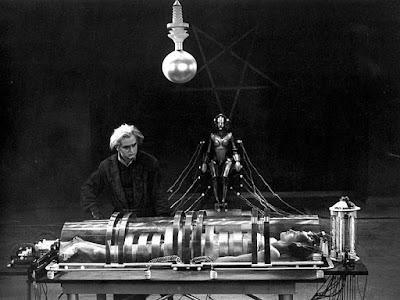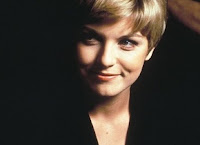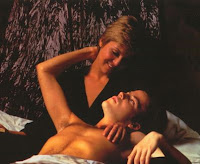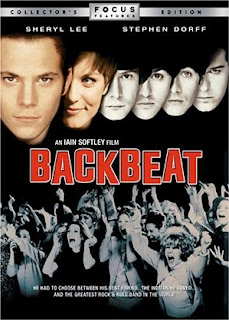However, these days the term "horror movie" elicits greater expectations of CGI eyeball kicks than of goosebumpy chills. While I love as much as anyone the high-tech eyeball kicks that serve the cause of creeping me the fuck out (The Ring and John Carpenter's The Thing come to mind), when I make a list of recent horror movies my strongest shock reaction is to warm up my coffee while wondering if I can find good parodies of them at Funny or Die or The Simpsons "Treehouse of Horror."
You know those classic Warner Brothers cartoons where Foghorn Leghorn lifts up the big snarly dog by the tail and whales on its ass with a two-by-four? That's what I'd like to do to everyone behind such recent whipped dogs as Jennifer's Body, The Human Centipede, and this year's remake of A Nightmare on Elm Street.
So I seek out those movies that genuinely know how to push my buttons — which means that they know where to find my buttons, when to push them (and, equally important, when not to), and how to push them in such a way that I'm not too aware that the movie has its long, bony finger on my button in the first place. They demonstrate that atmospherics, mood, and suggestion can be more effective than power-sprayer special effects, and that the scariest monsters are those you can't see, at least not clearly (e.g., Alien), because a monster imagined is always worse than a monster standing naked in the studio lights. (Controversially and arguably, our subject film at hand proves the point by, reportedly due to a producer's meddling, briefly violating it.)
For me, Robert Wise's The Haunting (1963) is a nonpareil of that second category. Accompanying it on my list of Top 10 Favorite Scary Movies are such films as The Innocents, Alien, Psycho, The Changeling, Quatermass and the Pit, The Wicker Man (1973 only), and a modest but effective thriller of necromancy and devilry that's a high point in British genre cinema, Night of the Demon.
This spooky gothic number from 1957 played in the U.S. in a recut release, 13 minutes shorter, titled Curse of the Demon.
Under either title, any self-respecting horror cineaste with a taste for period genre stylings and precision craftsmanship can go here for an intelligent script directed with mastery and style by Jacques Tourneur, protégé of the great Val Lewton in the '40s.
Stephen King, in his nonfiction book on horror fiction, Danse Macabre, places Demon on his list of films that contributed something of value to the genre, and gives it a special asterisk as one of his personal favorites. Not a bad recommendation, and it's only right to add that Night/Curse of the Demon is a movie that lots of its fans remember with affection and respect from their childhoods — because that's when it scared the crap out of them.
Here's a deceptively simple story exceptionally well told, its pulse beating beneath its skin with Tourneur keeping its lub-dub steady from start to finish.
American psychologist John Holden (Dana Andrews) arrives in rural England (not far from Stonehenge, which figures in the proceedings) to headline a parapsychology conference. A die-hard skeptic and debunker ("not a superstitious sucker"), his very public aim is to disprove the alleged black magic of "witch cult" leader Dr. Julian Karswell, played with smooth affability by Niall MacGinnis.
However, Holden's local colleague, Professor Harrington (Maurice Denham), has realized that their investigations into Karswell's group have uncovered demonological truths too terrible to dismiss, and Harrington begs Karswell to "stop what has begun." But the scientist recants too late. The urbane and polite sorcerer reminds Harrington that "You said, 'Do your worst,' and that's precisely what I did." Not even Karswell can halt what is underway, and deep in the night-black woods Harrington perishes violently by a giant hellish creature, his death occurring at a date and time predicted to the minute by Karswell.
Karswell had passed to Harrington an ancient strip of parchment inscribed with occult runes. The runes can invoke a demon that kills any person possessing the parchment. And not just any bush-league demon either — we're talking a monstrous fire demon "whose legend has persisted through civilization after civilization.... Babylonian Baal, Egyptian Sethtyphon, Persian Asmodeus, Hebraich Moloch."
The curse can be broken only by stealthily passing the parchment to someone else, and after Holden arrives and pokes too closely into Karswell's business, he turns out to be the latest unbeliever to whom Karswell slips the demonic death warrant.
Much of Demon's tension arises from our watching Holden pull the runes from his pocket and place them back again, the paper fluttering as if alive, while he refuses to recognize the terror stalking him. Holden is our anchor, our point of view that must be convinced of the dark forces on the loose in the dark, and his ghostly encounters in dark hallways, alone in the woods, in a lonely farmhouse, and other scenes where the overriding question is "Who's there?" do the job thoroughly.
Peggy Cummins also stars as Harrington's attractive niece, kindergarten teacher Joanna. She occupies the middle ground between Holden's obstinate skepticism and Karswell's witchcraft beliefs. Joanna is as level-headed as any educated modern woman, but unlike Holden she's willing to acknowledge the evidence that's before her eyes.
 Demon takes full advantage of this collision of realities: stiff-necked modern matter-of-factness vs. ancient supernatural magicks. It's a theme seen again and again in British genre films of the '50s and '60s, and a duality well suited for a British setting, where the isles' stiff-upper-lip pragmatism occupies the same space as Stonehenge and haunted castles. Karswell understands these dueling dogmas far better than Holden could ever hope to.
Demon takes full advantage of this collision of realities: stiff-necked modern matter-of-factness vs. ancient supernatural magicks. It's a theme seen again and again in British genre films of the '50s and '60s, and a duality well suited for a British setting, where the isles' stiff-upper-lip pragmatism occupies the same space as Stonehenge and haunted castles. Karswell understands these dueling dogmas far better than Holden could ever hope to.The cold light of reason, Holden is told, casts very deep shadows. It's Joanna who at the very end, after witnessing the horrific climax of Karswell's demonic conjurings, declares that perhaps it's better not to know some things.
After Holden calls Karswell "crazy," the rotund necromancer replies genially, "On the contrary, it's you who seem to be slightly unhinged," and we have to give Karswell the point on that round. It's worth considering the evidence that in this story's reality it's Karswell and his little cult who have the more accurate bead on how the modern cosmos operates, not Holden and his scientific materialism. Within the opening minutes, we in the audience witness hard evidence that the supernatural horrors are certifiably real. For the remaining running time that awareness steers our feelings regarding the doggedly skeptical Holden — he may be the narrative hero, but the guy is so pig-headed, so self-righteous, so willfully closed-minded that we know something's going to come along to corkscrew his thinking before the closing credits.
Although well-regarded today, Demon's reputation took time to amp up.
 Considered little more than filler during its initial distribution, in the U.S. Curse of the Demon was double-billed as the "B" entry with Hammer's Revenge of Frankenstein. We can imagine a typical American moviegoer's reaction to such a pair of dissimilar creature features — Hammer's garish full-color EC Comics sensibilities paired up with Demon's more sedate, suspenseful, black-and-white turns of the screw. (John McElwee at Greenbriar Picture Shows has a rather marvelous two-part history of that pairing's American distribution experience.) In the U.K., Night of the Demon was paired up with Ray Harryhausen's 20 Million Miles to Earth, making another set of mismatched socks.
Considered little more than filler during its initial distribution, in the U.S. Curse of the Demon was double-billed as the "B" entry with Hammer's Revenge of Frankenstein. We can imagine a typical American moviegoer's reaction to such a pair of dissimilar creature features — Hammer's garish full-color EC Comics sensibilities paired up with Demon's more sedate, suspenseful, black-and-white turns of the screw. (John McElwee at Greenbriar Picture Shows has a rather marvelous two-part history of that pairing's American distribution experience.) In the U.K., Night of the Demon was paired up with Ray Harryhausen's 20 Million Miles to Earth, making another set of mismatched socks. Over the decades it has accrued an admirable level of respect among genre devotees. That was helped by Forrest Ackerman's monthly subscription favorite, Famous Monsters of Filmland, which carried tantalizing images and descriptions of the movie throughout the '60s and '70s. Then the June/July '87 copy of Filmfax made it a cover feature. It's been only spottily shown on TV, but more and more it has appeared on the bill at international film festivals and university campuses. Today it's recognized as a first-rate specimen of its form, a textbook model of how to make an unsettling paranormal movie.
Over the decades it has accrued an admirable level of respect among genre devotees. That was helped by Forrest Ackerman's monthly subscription favorite, Famous Monsters of Filmland, which carried tantalizing images and descriptions of the movie throughout the '60s and '70s. Then the June/July '87 copy of Filmfax made it a cover feature. It's been only spottily shown on TV, but more and more it has appeared on the bill at international film festivals and university campuses. Today it's recognized as a first-rate specimen of its form, a textbook model of how to make an unsettling paranormal movie.And no doubt some of the film's appreciators discovered it thanks to a line from Rocky Horror Picture Show's famous opening song: "Dana Andrews said prunes / Gave him the runes / And passing them used lots of skills."
Jacques Tourneur was a master craftsman who was himself the son of director Maurice Tourneur. By 1942 he was Val Lewton's first director when Lewton headed the new horror unit at RKO. Their partnership led to some of the most lauded films of the genre: Cat People ('42), I Walked with a Zombie ('43), and The Leopard Man ('43), all displaying Tourneur's command of visually rich composition and precision-targeted atmosphere, with Cat People in particular being an artistic and commercial success. Tourneur went on to helm other fine work as diverse as westerns, comedies, and the film noir classic Out of the Past. He directed one of the earliest episodes of TV's The Twilight Zone.
With the arguable exception of a few key shots reportedly inserted against his wishes — more on that shortly — Tourneur concocted a tightly wound suspense film that would awe a Swiss watchmaker. Like Lewton before him, he employed every tool in his kit to control the goings-on and catch us off our guard.
Demon displays an exquisite sensitivity to the use of light and shadow, and Tourneur accents meticulously architectural dark compositions and sunny outdoor scenes alike with little epiphanies, sudden surprises, Hitchcockian camera work, and cool spritzes of humor. Every scene, shot, and sound counts, and the result is a deliciously "Lovecraftian" mood film that could make ol' H.P. himself shake off his New England funk.
The screenplay is credited to writer Charles Bennett, who scripted several of Hitchcock's better British films in the '30s (The Man Who Knew Too Much, The 39 Steps, Sabotage, etc.), and producer Hal E. Chester. They drew inspiration from M.R. James' Edwardian ghost story, "Casting the Runes," opening up the story into a screenplay that's clever, subtle, and refreshingly chooses not to insult its audience.
Other names here are cinematographer Ted Scaife (The Dirty Dozen, also contributed to The Third Man and The African Queen), production designer Ken Adam (Dr. Strangelove, numerous James Bond films, Addams Family Values), and composer Clifton Parker.
It's a rare pleasure to find a good villain, and Demon sports a terrific one in Niall MacGinnis' scene-stealing performance as Karswell, a character templated on that infamous showboating Satanist, Aleister Crowley. Fantasy fans will recognize MacGinnis as Zeus in Ray Harryhausen's Jason and the Argonauts. Because Demon avoids flinty good guy/bad guy dichotomies, here's an antagonist far removed from the cackling stereotypes of Satanic high priests in starched Ming of Mongo collars.
Against Dana Andrews' self-consciously flat and steadfastly boorish unbeliever, MacGinnis' Karswell is simultaneously several contradictory things — a dangerously powerful occult religious leader, a charming trickster who hosts children's Halloween parties at his remote country mansion (where he lives with his doting mother and performs magic shows as Bobo the clown), a sympathetic bloke just securing a living in his chosen field, and a genuinely frightening master of platinum-card witchcraft.
 |
| "Oh yes, I don't think it would be too amusing for the youngsters if I conjured up a demon from hell for them." |
Either way, when Karswell explains to his mother that their mansion and high-living lifestyle derive from what his followers give them out of fear, he confesses that he cannot stop what has begun because of his fear for his own life. "This house, the land, the way we live. Nothing for nothing. My followers who pay for this do it out of fear. And I do what I do out of fear also. It's part of the price.... Because if it's not someone else's life, it'll be mine. Do you understand, mother? It'll be mine "
Not even Holden, whose skepticism comes as rigid as a Stonehenge megalith, can ultimately deny the potentially lethal presence of supernatural forces associated with Karswell. Once Holden is told that he is marked for death by a gigantic demon next Tuesday at 10 p.m. sharp, those forces appear to be approaching closer and closer and....
A number of memorable moments stay with you after the closing credits:
- The thing in the woods. First pursuing Harrington, then Holden, that billowing smoky Hellmouth cloud out of which the demon materializes inspires Harrington's cry, "It's in the trees! It's coming!" — a line sampled by Kate Bush in her song "Hounds of Love."
- The wind storm. One of the best scenes occurs at the children's party, when Karswell gives Holden a pointed demonstration by whipping up a wind storm as casually as lighting a cigarette. The eerie magicks contrast with Karswell's Bobo clown makeup and glib offhandedness. "I didn't know you had cyclones in England," the befuddled scientist says, to which "Bobo" responds, "We don't. You could probably use a drink." Tourneur was justifiably proud of this scene, its effects accomplished with four strapped-down airplane engines.
- The Lewtonisms. By the time he signed on for Demon, Tourneur was a veteran director who had learned much by working for Lewton, whose contribution to the filmmakers toolchest included sudden emotional hits achieved through sleight-of-hand visual and aural legerdemain. Demon is punctuated by "Lewtonesque" touches that, through misdirection and expert timing, jolt you with simple sounds and objects. Some jumps here are delivered solely by blows from the soundtrack.
(In a possible hat-tip to Lewton's Cat People, Tourneur sends Holden into a confrontation with a house cat that transforms into an attacking leopard; the effect is one of two brief moments of embarrassment in the film, as the savage beast is too clearly stuffed. The second such moment occurs soon afterward with a shot of the moon and, nearby, three equally bright stars that blink off and back on in unison as if a stagehand leaned against a toggle switch.)
- The clinical hypnosis scene, in which a local True Believer — catatonic after a prior encounter with the demon of the parchment — finds relief by leaping through a high window, pointing to harrowing consequences in store for one of the attending hypnotists, the coolly rational Holden.
- The seance. After being etherically attracted by a screeching singalong of "Cherry Ripe", the deceased Prof. Harrington speaks from The Great Beyond to warn Holden that he is indeed quite satanically fucked.
- The climactic train sequence. From the final confrontation between Karswell and Holden to a doomed and futile chase along the tracks, leading to the towering millennia-old demon taking wrathful vengeance like one of Lovecraft's Otherworldly Terrors. In a manner not unlike what Jaws did for coastal beach swimming, Demon may have given riders on the 8:45 to Southampton reason to take a pause.
- The appearance of the titular demon, which brings us to this movie's controversial sticky wicket....
Sit down at any film fan convention bar over White Russians and Manhattans, and you can't engage in a learned discussion on Night of the Demon for more than 60 seconds before the heated topic of "It" comes up. "It" is the appearance of the title demon itself. Does it help the overall movie, or does it kneecap Tourneur's well-tuned mood and tone? No matter who starts the topic, a fight's going to break out and some poor M. Night Shyamalan fan is going to end up hiding under the table.
Different sources tell differing stories about how much Tourneur knew and approved (or didn't) regarding the demon's two boldly realized materializations, one near the beginning, the other at the climax. Did the director really never intend for the demon to be seen at all, his personal aesthetic calling for complete ambiguity? Or did he plan for its presence but visible only in hazy, ill-defined forms? Some Demon scholars have made a case for Tourneur knowing about the demon as we see it all along. After all, it was in the original script and its presence had been discussed pre-production. The full-figure winged version of the beast is so well integrated into the body of the film that it's hard to imagine Tourneur not having some foreknowledge of its presence.
Almost every account attributes the final demon images — achieved via some fairly obvious puppetry and an ornate animal-like head used for screen-filling close-ups — to 11th-hour insertions authorized by producer Hal Chester, who decided that a full-blown "monster" would make the film more commercial. (Notice that it's the central image in the theatrical poster art.) That decision is said to have outraged Tourneur, scenarist Bennett, and actor Andrews.
In the Summer '73 issue of Cinefantastique magazine, Tourneur himself gave his sharply worded remembrance:
Here's Tourneur speaking to the French film magazine Midi-minuit fantastique, as printed in Chris Fujiwara's Jacques Tourneur: The Cinema of Nightfall:"I wanted, at the very end, when the train goes by, to include only four frames of the monster coming up with the guy and throwing him down. Boom, boom — did I see it or didn't I?.... But after I had finished and returned to the United States, the English producer made this horrible thing, cheapened it. It was like a very different film."
"The scenes in which you really see the demon were shot without me. All except one. I shot the sequence in the woods where Dana Andrews is chased by this sort of cloud. This technique should have been used for the other sequences. The audience should never have been completely certain of having seen the demon. They should have just unveiled it little by little, without ever really showing it. They ruined the film by showing it from the very beginning with a guy we don’t know opening his garage, who doesn’t interest us in the least."
Likewise, Bennett is on record (in Pat McGilligan's Backstory 1: Interviews with Screenwriters of Hollywood's Golden Age) decrying that Chester...
"...messed up the screenplay quite a bit. It was so good, the screenplay, that it couldn't be completely destroyed, only half destroyed. It's still considered a good movie. I think the job Jacques Tourneur did with what Hal Chester gave him was awfully good. Hal Chester, as far as I'm concerned, if he walked up my driveway right now, I'd shoot him dead."
Also:
Honestly, I love his supercilious old-fartism when mentioning "cult-type organizations" in "peculiar areas." We call them movie lovers, Mr. Bennett, and they're damn near everywhere these days."I had to sit by while Chester made the biggest balls up of a good script that I have ever seen.... somehow the movie, perhaps because the fundamentals of my screenplay couldn't be entirely wiped out, succeeded. To add insult to injury I frequently get letters, even now, from cult-type organizations, asking me to write something about Night of the Demon because it is still loved in peculiar areas."
Britain's Today's Cinema at the time singled out the "thrills from well-staged giant fiery demon in the woods and on the railway." Danny Peary, in his first of three Cult Movies books, wrote "I believe most critics dislike the demon for no other reason than they know it was studio-imposed.... I am in favor of this vile creature as big as a house and ugly as sin.... It's the scariest monster in film history as far as I'm concerned (no matter that others think it ludicrous)." In his book Classics of the Horror Film, critic and film historian William K. Everson hailed the apparition as "such a lulu that it lives up to the fearsome descriptions of it."
I'm one of enthusiasts who sees the beast an essential pleasure of the film. Its first appearance early in the story sets up anticipation for an even bigger pay-off later on, and that pay-off delivers the goods.
To me, what we have here is mostly a matter of insensitive editing — the rather vague full-body shots look great, but the close-up model head is overused. It shouts when the rest of the film whispers.
So is the demon a flaw in an otherwise polished gem, or a worthwhile facet in the gem's structure? In either case, it's not on screen long enough to destroy the Night of the Demon's many virtues, and there's something to be said for a monster that sends eight-year-olds scurrying behind the couch, making them fans for life.
Music: "Shoot To Kill," by Quincy Jones, from the movie Mirage. Via Crime Jazz: Murder in the Second Degree.
Near at hand: Elizabeth, prepping a requested agent proposal for her novel, The Seventy.











